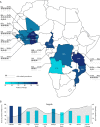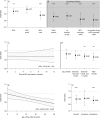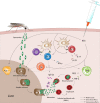BCG vaccination is associated with reduced malaria prevalence in children under the age of 5 years in sub-Saharan Africa
- PMID: 31798997
- PMCID: PMC6861070
- DOI: 10.1136/bmjgh-2019-001862
BCG vaccination is associated with reduced malaria prevalence in children under the age of 5 years in sub-Saharan Africa
Abstract
Introduction: Malaria continues to be a major cause of morbidity and mortality in sub-Saharan Africa (SSA) without effective interventions. Bacillus Calmette-Guérin (BCG) vaccine possesses protective non-specific effects, which extend beyond protection against tuberculosis. This study explores whether BCG is associated with protection against malaria in children under the age of 5 years in SSA.
Methods: We used data from the Demographic Health Survey programme, including 34 206 children from 13 SSA countries. BCG status was taken from vaccination cards when present; if not, mother's recall was used. Presence of malaria was defined as a positive rapid diagnostic test. Maternally reported presence or absence of fever in the previous 2 weeks defined symptomatic status. Multilevel logistic regression was used to account for the two-stage cluster sampling method.
Results: Of the 34 206 children, 12 325 (36.0%) children were malaria positive and 29 766 (87.0%) were BCG vaccinated. After correction for relevant child, maternal and household factors, BCG vaccination was associated with a lower malaria prevalence (adjusted OR (aOR)=0.94, 95% CI 0.90 to 0.98), especially among children of whom BCG information was retrieved from a vaccination card (aORcard=0.88, 95% CI 0.82 to 0.94). Restricting the analysis to children from regions with suboptimal BCG coverage increased the association (aORcard=0.81, 95% CI 0.73 to 0.89). We observed an increasingly beneficial association with each month of age of the child (aORcard=0.996, 95% CI 0.993 to 0.999). BCG associations were similar for asymptomatic (aORcard=0.86, 95% CI 0.81 to 0.92) and symptomatic (aORcard=0.89, 95% CI 0.78 to 1.01) malaria.
Conclusions: BCG vaccination is associated with protection against malaria. This protection is highest in regions with suboptimal BCG coverage. These results indicate a possible role for timely BCG vaccination in the protection of malaria and its elimination by reducing the transmission reservoir. If confirmed in further research, our findings have substantial implications for global efforts to reduce malaria burden.
Keywords: DHS; bacillus Calmette-Guérin; heterologous effects; malaria.
© Author(s) (or their employer(s)) 2019. Re-use permitted under CC BY-NC. No commercial re-use. See rights and permissions. Published by BMJ.
Conflict of interest statement
Competing interests: All authors have completed the Unified Competing Interest form (www.icmje.org/coi_disclosure.pdf) and declare no support from companies for the submitted work; no financial relationships with companies that might have an interest in the submitted work in the previous 3 years; their spouses, partners or children have no financial relationships that may be relevant to the submitted work; no non-financial interests that may be relevant to the submitted work.
Figures



Comment in
-
Making sense of emerging evidence on the non-specific effects of the BCG vaccine on malaria risk and neonatal mortality.BMJ Glob Health. 2020 Mar 5;5(3):e002301. doi: 10.1136/bmjgh-2020-002301. eCollection 2020. BMJ Glob Health. 2020. PMID: 32201627 Free PMC article. No abstract available.
References
-
- United Nations (UN) The millennium development goals report 2015. Available: http://www.un.org/millenniumgoals/2015_MDG_Report/pdf/MDG%202015%20rev%2... [Accessed 15 Dec 2017].
-
- World Health Organization (WHO) World malaria report 2018. Available: http://apps.who.int/iris/bitstream/handle/10665/275867/9789241565653-eng... [Accessed 15 Jan 2019].
LinkOut - more resources
Full Text Sources
Research Materials
